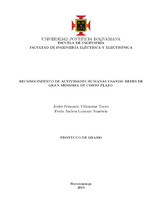| dc.contributor.advisor | Altuve Paredes, Miguel Alfonso | |
| dc.contributor.author | Villamizar Torres, Javier Fernando | |
| dc.contributor.author | Lizarazo Sanabria, Paula Andrea | |
| dc.coverage.temporal | 2019 | |
| dc.date.accessioned | 2021-05-11T15:48:58Z | |
| dc.date.available | 2021-05-11T15:48:58Z | |
| dc.date.issued | 2019 | |
| dc.identifier.uri | http://hdl.handle.net/20.500.11912/8499 | |
| dc.description | 109p páginas | spa |
| dc.description.abstract | El reconocimiento de actividades humanas es un tema de mucha relevancia debido a su amplia gama de aplicaciones. Diferentes enfoques han sido propuestos para reconocer actividades humanas, desde la comparación de señales con umbrales hasta la aplicación de técnicas de aprendizaje automático y profundo. En este trabajo se realiza la clasificación de seis actividades humanas usando redes LSTM bidireccionales y, como
representación de las señales inerciales a ser explotadas por estas redes, se propone la representación de estas señales en funciones de modo intrínseco (IMF) usando la descomposición empírica en modos por conjuntos completa con ruido adaptativo mejorada (ICEEMDAN). Las actividades clasificadas fueron: caminar, subir escaleras, bajar escaleras, estar sentado, estar parado y estar acostado. Los registros con las señales inerciales (acelerómetro y giroscopio) de 2.56 segundos (128 muestras) fueron recolectados por un teléfono inteligente a 30 voluntarios y se encuentran disponibles en el UCI Machine Learning Repository. En primer lugar, las señales inerciales fueron estandarizadas para llevarlas a una misma escala y fueron descompuestas en IMF usando la ICEEMDAN. Posteriormente, las IMF fueron segmentadas (divididas) en nueve segmentos de 64 muestras con solapamiento de 12.5% e introducidos a una primera red con cuatro salidas para identificar las actividades
dinámicas y las estáticas como una única clase denominada “statics”, arrojando una exactitud del 98.86%.
Luego, las IMF sin segmentar de los registros asignados a la clase statics fueron introducidos a una segunda red para clasificar sus tres actividades, dando una exactitud de 88.46%. En total se obtuvo 92.91% de exactitud para clasificar las seis actividades humanas. Este desempeño se debe a que la ICEEMAN nos permitió extraer información que se encontraba implícita en la señal, además la segmentación de las señales permitió que la red pudiera discriminar entre actividades estáticas y dinámicas. | spa |
| dc.description.abstract | The recognition of human activities is a topic of great relevance due to its wide range of applications. Different approaches have been proposed to recognize human activities, ranging from the comparison of the signals with thresholds to the application of deep and machine learning techniques. In this work, the classification of six human activities is performed using bidirectional LSTM networks and, as a representation of the inertial signals to be exploited by these networks, the representation of these signals in intrinsic mode functions (IMF) is proposed
using improved complete ensemble empirical mode decomposition with adaptive noise (ICEEMDAN). The classified activities were: walking, walking downstairs, walking upstairs, standing, sitting, and lying down.
Records with inertial signals (accelerometer and gyroscope) of 2.56 seconds (128 samples) were collected by a smartphone to 30 volunteers and are available in the UCI Machine Learning Repository. First, inertial signals were standardized to take them to the same scale and were decomposed into IMF using ICEEMDAN. IMF were then segmented (split) into nine segments of 64 samples with 12.5% overlap and introduced to a first network with four outputs to identify the dynamic activities and the statics as a single class called “statics”, giving 98.86%
accuracy. Then, the non-segmented IMF of the records assigned to the statics class were introduced to a second network to classify their three activities, giving an accuracy of 88.46%. In total, 92.91% accuracy was obtained to classify the six human activities. This performance is because ICEEMAN allowed the extraction of information that was embedded in the signal, and the segmentation of the signals allowed the network to discriminate between static and dynamic activities. | eng |
| dc.format.mimetype | application/pdf | |
| dc.language.iso | spa | |
| dc.publisher | Universidad Pontificia Bolivariana | spa |
| dc.rights | Attribution-NonCommercial-NoDerivatives 4.0 International | * |
| dc.rights.uri | http://creativecommons.org/licenses/by-nc-nd/4.0/ | * |
| dc.subject | Dectores | spa |
| dc.subject | Automatización | spa |
| dc.subject | Reconocimiento de patrones | spa |
| dc.subject | Señales y señalización | spa |
| dc.title | Reconocimiento de actividades humanas usando redes de gran memoria de corto plazo | spa |
| dc.type | Trabajo de grado | spa |
| dc.publisher.department | Escuela de Ingenierías | spa |
| dc.publisher.program | Ingeniería Electrónica | spa |
| dc.type.hasVersion | publishedVersion | spa |
| dc.description.sectional | Bucaramanga | spa |
| dc.description.degreename | Ingeniero Electrónico | spa |


